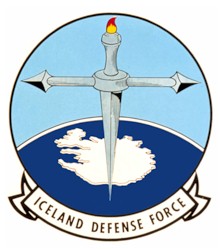Iceland Defense Force



TheIceland Defense Force(Icelandic:Varnarlið Íslands;IDF) was amilitarycommandof theUnited States Armed Forcesfrom 1951 to 2006. The IDF, created at the request ofNATO,came into existence when the United States signed an agreement to provide for the defense of Iceland, which has onlylimited defense forces.
Organization
[edit]The IDF was formally headquartered atNaval Air Station Keflavik,though its base was actually at Miðnesheiði near Keflavík. Commander, Iceland Defense Force was a U.S. Navy Rear Admiral with three other titles and roles: Commander, Iceland Sector ASW Group (CTG-84.1), Commander, Fleet Air Keflavik, andNATOIsland Command Iceland. Commander Fleet Air Keflavik (COMFAIRKEF) was the senior Navy command in Iceland, responsible for the operational readiness of Navy units assigned. The commander of Fleet Air Keflavik was the operational commander in charge of all Navy and anti-submarine warfare operations. Administratively, COMFAIRKEF reported toCommander, Naval Air Force U.S. Atlantic Fleet,located inNorfolk, Virginia.
The IDF was a subordinate unified command ofUnited States Atlantic Commandfor a long period before passing to the control of the renamedUnited States Joint Forces Command.[1]From October 2002 until its disbandment, it was under the control of theUnited States European Command.
The IDF was composed ofUnited States Navy,United States Marine Corps,andUnited States Air Forcepersonnel as well as local Icelandic civilians. In addition, there were a fewArmyandCoast Guardpersonnel attached to this command.
From 1951 to 1959, a secret ban was imposed by the Icelandic government on the stationing of black US troops in Iceland. This ban was disclosed in late 1959. The Icelandic government relented somewhat from this policy in 1961, when it declared that it "will not oppose the inclusion of three or four colored soldiers in the Defense Force, but hopes that they will be carefully selected". The number of black troops increased gradually throughout the 1960s, and all restrictions were most likely unofficially withdrawn in the 1970s or 1980s.[2]
There were more than 25 different commands of various sizes attached to the Iceland Defense Force. Although staffing varied over the years, it was approximately 1350 U.S. military personnel (not including Reservists), 100Department of Defensecivilians, and 650 Icelanders, both civilians and firemen given military training manning the local Naval Firefighting team, as well as military members fromNorway,Denmark,Canada,theNetherlands,and theUnited Kingdomworked onNAS Keflavik.A contingent of theUnited States Marine Corpswas responsible for ground defense.
The U.S. Air Force component of the force was the85th Group.The air forces stationed in Iceland included a rotationalP-3 Orionpatrol squadron deployed forward from the U.S. Navy's Patrol Wings Atlantic, and theF-15sof the85th Group.Commander Dennis Corrigan, Fleet Air Keflavik's operations officer, commented toJane's Defence Weeklyin 1996 that "Keflavik is the only place where a US Navy flag officer has both P-3s and USAF F-15s working for him.... We have developed a joint tactical doctrine: F-15s providing air superiority to allow the P-3 to do its job, whether its mining,anti-submarine warfareor something else. "[3]With the reduction in Patrol Wings Atlantic to ultimately seven squadrons by 1994, commitments at NAS Roosevelt Roads and Sigonella were reallocated, with Patrol Wings, Pacific taking up the Caribbean tasking to allow a full complement of P-3s in Sicily.[3]
In the event of a major ground threat, the Army component, U.S. Army Iceland (ARICE), would have mobilized and become responsible for the ground defense of Iceland. ARICE consisted almost entirely of reserve components (from 1963 until 1994, the main formation was the Army Reserve's187th Infantry Brigade) in the United States, and limited numbers of personnel participated in on-site training maneuvers. Logistical support was to be provided by the167th Support Group (Corps),another Army Reserve unit. Neither the 187th Infantry Brigade nor the 167th Support Group were ever deployed to Iceland.
From 1970[4][clarification needed]to 2006, the Iceland Defense Force provided between 2% and 5% of Iceland's GDP.[4]
Exercises
[edit]Operation Nordic Shield II was held in the summer of 1992. As they did five years before, units of the94th Army Reserve Command;principally the187th Infantry Brigade (Separate),the167th Support Group (Corps)and their subordinatebattalionsandcompanies;deployed toCanadian Forces BaseGagetowninsouthern New Brunswick,to simulate the defense of Iceland againstWarsaw Pactforces, the CAPSTONE mission of both the 187th and 167th. Part of the 1992 exercise included lanes training as part of theUnited States Army Forces Command's "Bold Shift" initiative to reinforce unit war-fighting task proficiency.
OperationNorthern Vikingis a series of defense of Iceland exercises, held biennially for several years. In 2006 the frequency was increased.
Termination
[edit]On 15 March 2006, theU.S. Ambassador to IcelandCarol van Voorstannounced the decision of the United States to withdraw the Iceland Defense Force before the end of September 2006. On September 30, the American military withdrew its final four Air Force fighter jets and a rescue helicopter squadron fromKeflavík.[5]Although NAS Keflavík has closed and the American military has left Iceland, the United States is still responsible for defending its ally and the facilities at Keflavík will still be available, in the event that a "surged expeditionary presence" is deemed necessary.[6]
The Icelandic defence contractor Kögun (now part ofAdvania) has been contracted to operate and service U.S. Navy communications equipment and facilities left behind.
It was reported in February 2016 that the US Navy would return to Iceland to track Russian submarines.[7]
See also
[edit]- Military of Iceland
- Icelandic Coast Guard
- Iceland Crisis Response Unit
- Icelandic Air Policing
- Naval Air Station Keflavik
- Iceland in the Cold War
Further reading
[edit]- Jane's Defence Weekly30 March 1991
- Government of Iceland-Foreign Affairs,National Security
References
[edit]- ^Pike, John."Iceland Defense Force".www.globalsecurity.org.Retrieved18 April2018.
- ^Ingimundarson, Valur (2004-10-01). "Immunizing against the American Other: Racism, Nationalism, and Gender in U.S.-Icelandic Military Relations during the Cold War".Journal of Cold War Studies.6(4): 65–88.doi:10.1162/1520397042350892.ISSN1520-3972.S2CID57559468.
- ^abJoris Janssen Lok, "No thaw in Cold War for Iceland",Jane's Defence Weekly,5 November 1994, p.15
- ^abThorhallsson, Baldur, ed. (2018)."Small States and Shelter Theory: Iceland's External Affairs".Routledge. p. 67.
- ^White, Josh (17 March 2006)."U.S. to Remove Military Forces And Aircraft From Iceland Base".Retrieved18 April2018– via www.washingtonpost.com.
- ^"Geopolitical Diary: The U.S. Withdrawal from Iceland".Stratfor.Retrieved18 April2018.
- ^"Navy returning to former Cold War base in Iceland".Stars and Stripes.Retrieved2016-02-09.
